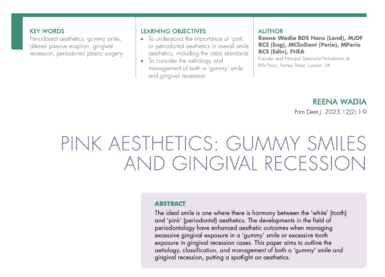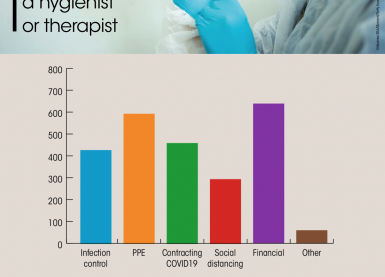June 21, 2021

M – Maintenance
Emphasise the importance of long-term maintenance/supportive periodontal therapy at the start of treatment as patients may lose motivation if they only later find out that there will be a life-long commitment to care. Explain the benefits of a maintenance programme including limiting relapse in disease and reducing the rate of tooth loss (Trombelli 2015).
O – Ownership
Reinforce the patient’s responsibility for their periodontal health. Helpful phrases include: “you do 70% of the work, I only do 30% of the work” and “my job is to give you the power and knowledge to treat your own disease and not rely on me”.
T – Technology
Make the most of technology when motivating your patients. Fitbits are a popular activity tracker and help motivate individuals to exercise more. In the same way, technology attached to oral hygiene products can be useful to motivate the patient to engage in optimal oral hygiene regimes. For example, the Oral-B Genius combines motion sensor technology located in the brush and video recognition using a smartphone’s camera, so that all areas of the user’s mouth can be tracked. This means the patient knows exactly where they’ve brushed and where they’ve missed! Patients receive instant feedback on the brushing of each zone of the mouth via the Oral-B App, including guidance on pressure applied and brushing duration. The brushing history can also be sent to the clinician, which is motivating for the patient, as they know someone else will be analysing this at a later point.
I – Information
Providing an adequate amount of information to the patient is important so that they can understand the disease process and treatment required. If they don’t understand this then the motivation will not be there to do anything about it. Explain what a pocket it, explain that we have to probe to get an objective measurement of the condition and explain that there is an increased risk of tooth loss as pocket depth increases (Matuliene 2008).
V – Value
Provide value to the treatment to motivate the patient to accept and comply. There is now a supporting evidence base to suggest that an improvement in periodontal health has a positive affect on quality of life and general health (especially conditions such as diabetes).
A – Applaud
Always try and find something positive for the patient. If the patient has previously been unaware of the extent/severity of their periodontal condition, it can be quite disheartening learning about the truth. Point out something positive to keep up the patient’s motivational levels. This could be the fact that the patient has healthy teeth (rather than gums), the periodontal health in some areas is good or they haven’t lost any teeth yet. When motivating the patient to improve their oral hygiene, applaud something they are already doing well before suggesting changes. To maintain motivational levels it may be helpful to write a letter of motivation or encouragement.
T – Terminology
Use the right words i.e. bacteria/bugs can be more emotive than just plaque/ calculus. Avoid jargon and keep explanations simple. Use analogies, e.g. when explaining the importance of periodontal health as a foundation for everything else, you can say that just as you wouldn’t build a house on sand, it wouldn’t be sensible to have restorative work unless the periodontal condition is healthy/strong as other treatment just won’t work.
E – Enthusiasm
Be an enthusiastic clinician and this will rub off onto your patients. A helpful phrase is: “The good news is that we can help you!”Be enthusiastic about the fact that periodontal treatment works and sound enthusiastic about the results your other patients have achieved.
Notes from a webinar by Amit Patel BDS MSc MClinDent FDS RCSEd MRD RCSEng,
Specialist in Periodontics and Implant Dentist, Principal Specialist at Birmingham Dental Specialists



